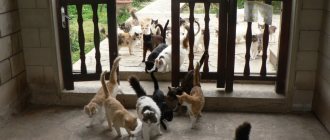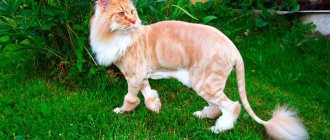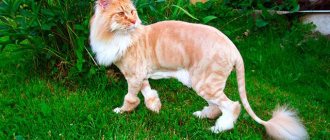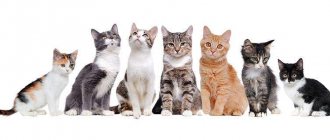The cat family is cunning animals that, even with love and respect for their own owners, put themselves and comfort first. These cats include the domestic puma, another name for Messi. The animals are playful, affectionate, but with well-developed hunting instincts. The puma behaves like any domestic cat, differing only in its particularly large size.
The key features and behavior of domestic pumas are clearly illustrated by the example of a pet named Messi.
History of the discovery of the Puma species
Humanity has known this unique American small cat for a long time; back in the Middle Ages, the first scientific description appeared, made by the Spanish Count Pedro Sierra Leon, who made many geographical discoveries and spent most of his life traveling around Central and South America. The work “Chronicles of Peru” written by him is the first unique travel encyclopedia.
The Spaniard was introduced to this wild cat by local Indian tribes, who took the animals inhabiting the jungle very seriously. So, for the Incas, the Puma was always a representative of the heavenly deity, for the Apaches they were harbingers of death, for the Cherokees these animals were simply inviolable and sacred.
After Spain enslaved the tribes of Central and South America, hard times came for everyone - for the local Indians, for the flora and fauna, and for the invaders themselves. Invasions of huge Pumas into camps each time ended with the disappearance of cows and mules, and the Indians did not allow the Spaniards to kill the sacred animals. Even expensive gifts to the leaders could not shake the persistence of the warriors. After all, the Indians believed that Pumas protected their tribes from the invasion of evil spirits and were ready to sacrifice mules to them.
Cougars at that time lived over very vast territories - practically from the southern shores of the Alaska Peninsula to the Strait of Magellan. In the end, the white hunters won - a widespread hunt was announced for Pumas. At first it went under the slogan of protecting livestock, but then the Yankees liked the hunting trophies themselves from cruel fun - luxurious skins, fangs, claws, and the settlers did not refuse the meat of these cats.
By the end of the 20th century, these gorgeous wild cats came to the brink of complete destruction. Nowadays, hunting for Puma is prohibited in America; the population size is being intensively restored in numerous nature reserves and national parks.
Dreams involving Puma
People have always been attracted to this mysterious predator; esotericism even tries to interpret dreams with this wild cat.
- Often this cat in a dream is a harbinger of a new love affair.
- If you dream of hunting an animal, then you should think about your own mental world, rethinking your life.
- If you dream of a Cougar being captured or caught in a trap, this foretells failure in love affairs.
- A healthy, beautiful animal, proudly striding through the forest, a symbol of strength, splendor, elegance, passionate nature, sensuality.
- If a woman dreams of the Mountain Lion, then most likely there is a lot of gossip and slander around her, and most often she herself provokes and spreads them.
- For a man, a dream with a Puma symbolizes sexual dissatisfaction and melancholy.
- If you dream of a Cougar on a harness and leash, this is a hint that you should control your desires and aspirations.
- An angry, growling beast signals a major conflict brewing.
- A young and brilliant female Puma is a symbol of a calm, blessed life.
- An aggressive male is a warning about imminent troubles in your personal and business life.
- If you dream of a Mountain Lion during a hunt, then in life you should adhere to a neutral position in difficult moments in order to avoid future difficulties.
- If a handsome animal lies on a tree branch, and the sleeping person admires it, then, most likely, hot expectations will not come true.
- If Puma is afraid, but approaches a person in a dream, this indicates that all plans will soon be fulfilled.
Puma photo gallery:
1111
Appearance
Adult males weigh significantly more, almost 3 times the weight of females. A male can weigh about 70 kg, although some individuals can gain as much as 100 kilograms, with a body length of almost 2 meters. The height at the withers reaches more than 80 cm, with a tail length of more than 70 centimeters. The puma is distinguished by a long and fairly flexible body, with a fairly proportional head, as well as medium-sized round ears. The animal's eyes are beautiful, with a peculiar black border, and the predator has a rather attentive gaze.
The front paws have 5 toes, and the hind paws, which are wider and more powerful, have 4 toes. The claws are retractable, quite sharp and curved, which allows the predator to securely grab and hold its prey. In addition, they help the animal to climb trees without much effort. These animals have short and coarse hair, but quite thick. The main color resembles that of deer, which form the basis of the diet of this predator.
Interesting moment! The color of the coat is made in red, gray-brown, sand and yellowish-brown shades. The offspring that are born have a slightly different body color.
Their coat is literally dotted with dark, almost black spots, stripes are visible on the front and hind legs, and characteristic rings are visible on the tail.
The main color of this predator depends on the living conditions, therefore animals living in tropical conditions have more reddish shades, and animals living in colder regions are characterized by a color made in gray tones.
Description and characteristics of the breed
The domestic puma is a member of the cat family from the United States of America. The length of the animal reaches 100-170 centimeters. Body weight is up to 100 kilograms. Males are 30 kg larger than females. Main characteristics of cats of this breed:
- Torso. Flexible and long, well-formed muscles.
- Limbs. Strong, powerful, but short. The hind ones are much more massive than the front ones.
- Head. Round, small relative to the body.
- Tail. Long, strong, equally pubescent.
- Paws. Extensive, with pointed and curved claws. The hind legs have 4 phalanges, the front ones - 5. The pads are oval in shape and consist of three parts - a common feature of all puma cats.
- Wool. Dense and short. Hard to the touch.
- Color. Adults are monochromatic, gray-chestnut or brown-yellow. There are white tan marks on the chest, belly and neck. There are dark markings on the muzzle. Ears and tail with black edge. Pumas from regions with hot climates are smaller in size and more red in color. The coloring of puma babies is different. The fur is covered with black spots and stripes. The tails have dark rings. The spots on the coat lighten by the age of one, and completely disappear by two.
Puma subspecies
Almost until the year 2000, scientists identified about 30 subspecies of this predator, based on morphological characteristics. Nowadays, pumas have been classified into 6 subspecies, taking into account the genetic characteristics of the animals, as well as their habitat.
Therefore, predators are defined depending on their belonging to certain genomes, as well as their habitat areas.
In connection with these factors, the following predators are distinguished:
- Puma concolor costaricensis, native to Central America.
- Puma concolor couguar, found in North America.
- Puma concolor cabrerae. This subspecies inhabits central South America.
- Puma concolor capricornensis. This species of predator is found in the eastern regions of South America.
- Puma concolor puma is found in the southern regions of South America.
- Puma concolor concolor. Animals of this subspecies live within the northern regions of South America.
Interesting to know! In the wooded and swampy areas of South Florida, a rather rare subspecies of Puma concolor coryi, called the Florida cougar, was found.
The most numerous populations are found in the Big Cypress National Preserve in the USA. In 2011, there were about 160 individuals, after which the animals were listed in the International Red Book (IUCN), defining the status as a subspecies in critical condition. Unfortunately, this subspecies disappeared due to human activity, who haphazardly drained the swamps, and also hunted the predator for sport. In addition, inbreeding, which consisted in the fact that closely related animals mated with the hope of increasing the total number of predators, also has some relation to this negative factor.
Geographic range and habitat
The puma boasts the widest distribution range of any member of the New World class of mammals. Only lynx and forest cats can compete with it. During the European settlement of the New World, the puma occupied the entire territory of what is now the 48 southern states of the United States and southern Canada. Currently, mountain lions are primarily found west of 100 degrees west longitude (roughly central Texas to Saskatchewan, excluding southern Texas), as far south as Chile.
Cougars prefer a variety of habitats, including grasslands, chaparral, woodlands, and swamps. This animal is just as at home in the Rocky Mountains as it is in the Argentine pampas or the dense Amazon rainforest. However, mountain lions avoid agricultural lands, plains, and similar habitats lacking topographical or vegetative cover.
Puma's diet
Cougars are classic night hunters. Animals usually go out for prey in the twilight hours, but the process can drag on for a long time. The fact is that the main diet of this predator is large ungulate mammals, usually several times larger than a cat in size.
If Cougar attacked elk and buffalo in daylight, and even in open areas, then it would not be worth talking about instant prey and the outcome of the fight.
The Mountain Lion is very cunning and cautious. He tracks down prey on the paths leading to a watering hole, entering from the windward side so as not to frighten off the prey ahead of time. Then follows a lightning-fast jump onto the animal’s scruff, and now the sharp fangs tear the neck vein, break the spine or strangle.
One should not think that Pumas feed exclusively on artiodactyls. These predators are omnivores and do not refuse any protein food. Their diet may also include:
- rodents – mice, marmots, voles;
- proteins;
- opossums;
- rabbits;
- coyotes;
- other predatory cats;
- porcupines;
- sloths;
- monkey;
- prairie dogs;
- beavers;
- armadillos;
- birds;
- fish;
- insects and snails.
Ungulates still occupy the majority of the Cougar's diet. This is most often:
- deer – black- and white-tailed, pampas;
- moose;
- wapiti;
- caribou;
- bighorn sheep.
In Latin America, Mountain Lions often attack humpless camels and also fight alligators. Any Pumas are able to fight baribals, grizzly bears.
In times of famine, the Puma gladly robs cattle farms, destroying any animals - cows, horses, mules, poultry, dogs and cats.
This predator is capable of eating up to one and a half tons of meat in a year. Having laid down the deer, the animal eats only part of the carcass, up to 10 kg, and prefers to hide the rest in secluded places. In general, this animal tends to make reserves, which are often stolen by scavengers and even by people, if hunters specifically followed the Puma for this purpose.
Despite its tendency to be nocturnal, a very hungry Cougar is capable of hunting during daylight hours.
The difference between a Puma and a Panther
First of all, it should be noted that the four largest wild cats belong to the Panther genus - Tiger, Lion, Leopard, Jaguar. It would probably never occur to anyone to compare the Puma with the first two; these animals are too dissimilar in appearance, size, morphology, and color.
Leopards and Jaguars are smaller than Lions and Tigers, but their color is very bright “tabby”, so it is difficult to confuse them with the same-colored Cougar. In addition, only the Jaguar and the Mountain Lion can cross their native habitats, and only these species live in the Americas.
This means that we can only talk about the black Jaguar, which ordinary people usually call the Panther. These individuals are rare and most often they are not charcoal, but dark chocolate. There is also a black Panther - a melanistic Leopard, but the Leopard lives in Africa and Asia, so we will not talk about it here.
Black Jaguars still have spots on their bodies, although with this color it is difficult to see them. Pumas may in some way externally resemble such a Jaguar-Panther, especially their colored dark brown isomorphs.
Nevertheless, such a Panther and a Puma will still have a different coat color in terms of the saturation of dark shades. The color of the Cougar is lighter in any case and there are no spots or stripes on it, because the very name of the animal means “one-color.”
If we talk about the genetic nature of animals, then the black Panther is a melanistic cat, but the dark brown Puma is not. Such mutations have not been identified in this type of cat, nor has albinism.
Both the Panther and the Cougar are flexible and agile animals with strong paws and long powerful tails. Therefore, something in the silhouette of cats may be common. In Pumas, the hind limbs are much longer and stronger, which means that the sacrum is located higher, and the line of the back has a deflection, unlike the straight line of the Jaguar.
The panther is a large cat and is capable of growling and roaring loudly. The Puma has a different structure of the tongue and larynx; it cannot roar, but, unlike the Jaguar, it can purr and meow.
Black Panther or Melanistic Jaguar
Both Pumas and Panthers are solitary hunters who pair up only during the mating season. But the first cat loves forests and mountains, it’s not for nothing that it is called the Mountain Lion, and the Jaguar prefers the hot tropical jungle.
Maintenance and care
To properly keep pumas in captivity, the animals should be provided with a specialized equipped room - an outdoor cage (aviary). This iron structure can be up to 3 meters in height. It is closed on three sides by a strong lattice and on the fourth by strong wooden boards. There must be a small house attached to the side - a shelter for the animal in bad weather and a place where it spends time during the cleaning period. For a puma, the minimum cage size must be 30 square meters, and the house must be 2x2 meters. To strengthen muscles and maintain shape, animals need enough movement, which can be provided by hanging a piece of meat from a tree on a strong rope. In addition, the enclosure should have toys - strong, dense balls, inner tubes from car wheels, strong cables and wooden sticks.
If a cat grows up next to a person from infancy, then you can take him home. It is necessary to prepare a place for resting and feeding. It is recommended to walk the domestic cougar in the fresh air, where it has the opportunity to actively run and play, but always on a leash. The animal should be bathed when it is heavily soiled with special shampoos. You will need to wipe your eyes and ears infrequently with a soft, natural cloth soaked in warm water. The cougar needs to be brushed several times a month; it practically does not shed.
How to choose a kitten
Abyssinian kittens are ready for sale from the age of two months. But it’s better to wait, let them grow under the supervision of experienced breeders for up to 3-4 months in order to learn communication and behavior skills.
To choose the right purebred kitten, contact trusted nurseries, ask for documents and, of course, carefully examine the animal. There should be no bald spots on your future pet's coat, the skin is clean, without scratching, the eyes are clear, and the belly is not bloated. Ask if the kittens have been vaccinated.
Behavior and lifestyle
Cougars prefer to lead a solitary lifestyle, forming pairs only during the mating season, which lasts only one week, while the female and her offspring stay together until the kittens become completely independent. Adult males behave aggressively towards each other, but young males behave very friendly. The total number of these predators depends on the amount of game, so on one hundred square kilometers you can find one owner of such a territory, and in areas that are half the size - more than ten individuals.
The plot, which is under the control of the male, can be up to 350 square km or 10 times less, depending on the availability of food supply. It should be noted that each territory never overlaps with the territory in which relatives hunt. They mark their territory using urine and feces, as well as by leaving scratches on trees. Cougars constantly move around their areas, and the intensity of such migration depends on the time of year. These predators feel great on any rough terrain, as they are considered record holders for high and long jumps.
Puma is capable of:
- Long jump 7 meters or more.
- Jump almost 5 meters in height.
- Jump from a height of up to 18 meters.
Interesting to know! These predators are capable of accelerating to a speed of 50 km/h, but only for a short time, while the animals perfectly overcome mountain slopes, easily climb trees, and also jump from rock to rock. Cougars feel good in water, but do not have much interest in the water element.
The predator goes hunting at dusk, and during the daytime these animals sit out or lie down in their shelters. For many years, people believed that cougars made heartbreaking sounds, but, as it turns out, these are just fantasies born out of chilling fear. Cougars make loud noises only during breeding periods, and the rest of the time they make sounds characteristic of all “felines,” including the familiar “meow” sound.
Lifestyle of a domesticated puma
In its natural habitat, the cougar is a solitary animal. The puma looks for a mate only during the mating season. The predator marks its territory with scratches on rocks and trees, as well as with secretions. If you are planning to buy a puma kitten for your home, then immediately keep in mind that in captivity a mountain lion, as this cat is also called, will behave the same way. Little kittens are playful. They make good contact with people, but from the first months of life they often strive to demonstrate a leadership character. Adults are more reserved. During the day they like to sleep and bask in the sun; in the evening their activity increases significantly - it’s time to hunt. Therefore, you should buy a cougar or an animal whose price is affordable for you to place in a separate room or outdoor enclosure. Otherwise, the cougar will not give rest to the owners, will irritate with night noise and interfere with rest.
Colors
The following colors of Abyssinian cats are accepted by the standards: sorel, fawn, wild, blue. There are also several unrecognized varieties in brown, chocolate, silver, and lilac.
- The Abyssinian fawn cat wears a light brown (beige) coat with cocoa-colored markings.
- The blue Abyssinian is characterized by having a warm gray, blue-gray or beige coat throughout the body, with darker markings on the face and tail.
- The sorrel color is the color of the red cat. It is covered with reddish-red fur, and chocolate markings are clearly visible on its face and tail.
- The wild color of the Abyssinian is the most common. The coat is black, dark brown or ocher. A black tail and muzzle complement the appearance of cats with wild colors.
A color in which there are white areas on the chin is not valued; the fewer there are, the higher the place the beauty occupies at the exhibition.
Allergy to Abyssinians
It is possible to develop an allergy to the Abyssinian breed, but this is unlikely. If a cat is said to have a hypoallergenic coat, it means that they produce fewer allergens than others. Abyssinians are one of the breeds called by owners and breeders as anti-allergenic.
Reproduction
There is no specific time of year for the animal to reproduce. Copulation, just like with other cats, is accompanied by deafening screams of males and fights. Estrus in females lasts 10 days. Pregnancy lasts 80-95 days. 1-6 babies are born in a litter; a puma kitten weighs 225-450 grams and has a body length of 30 centimeters. The color of kittens is chocolate with black dots and stripes, and changes during the first year of life. Babies' eyes open within a week. At this time, the first teeth appear.
From six weeks they begin to consume adult food, but continue to be fed with mother's milk. During this period, females have to obtain food several times more than usual. Until the age of two, kittens are close to their mother, then they go in search of personal hunting areas. Females reach puberty at 2 years and 6 months, and males only at 3 years. In natural conditions, the life expectancy of a cougar is 15-20 years; in domestic conditions, it all depends on maintenance, care and nutrition.
Breeding season and young development
Photo: www.evanmathieson.net
Mountain lions breed year-round, but at higher latitudes, birth rates peak during the summer months. The time interval between births is about two years, but this is shortened if the litter dies or disperses early.
Cubs are carried for an average of 90 days; the average litter size usually does not exceed three young, but a female can produce up to six kittens at a time. Spotted and blind cubs at birth weigh about 400 grams and have an average height of 30 cm. The “maternity hospital” is set up in almost impenetrable thickets of vegetation. The cubs are taken away from it when they are 1.5-2.5 months old.
Females feed and raise the young without the support of adult males, since they sometimes kill other people's kittens. Cubs do not leave their mother until 10-26 months, but the vast majority of them die before reaching this age. It is noteworthy that captured puma kittens are easy to tame.
Photo: Tierra Hotels
At the age of two, young females scatter in the range of 10-140 km (average 40 km); young males often run further, sometimes covering a distance of over 250 km. It can take them a year to become part of the breeding population, during which time an individual will successively occupy and leave one to five small temporary home territories. If a home range can be established, the cougar can be expected to live here for another 7-11 years.
- Breeding interval: every two years
- Breeding season: all year
- Average number of offspring: three cubs
- Gestation period: 82-96 days
- Average age of sexual or reproductive maturity: 2.5 years (females), 3 years (males)
Puma and man
Despite the fact that Theodore Roosevelt created a society for the protection of animals, this society was negatively opposed to pumas, so they began to be systematically shot in the United States. As a result of such activities of this society, several hundred thousand of these animals were destroyed. At the same time, it is worth noting that this predator does not attack a person for no reason, but tries to avoid such an encounter. For almost a century and a half, only a few dozen such attacks were recorded, most of which occurred on the island. Vancouver.
When in areas where pumas are found, a number of precautions must be taken. They are expressed as follows:
- Don't leave children alone.
- Carry a powerful stick with you.
- Don't be alone.
- When meeting a predator, do not run away from it, but look into its eyes and make scary sounds.
A cougar will not attack a tall person, so its targets of attack are either children or small people who find themselves on its territory at night.
What does the price depend on?
The cost of pumas depends on several criteria:
- Age. The cost of adult trained animals exceeds the price of kittens. And newborn kittens are cheaper compared to monthly kittens.
- Paula. Females are more expensive than males.
- Vida. There are six subspecies of mountain lions. The rarer ones are more expensive.
Important! In some cases, intercity delivery is required, the cost of which is discussed with the seller separately.
Not all subspecies can be purchased on the territory of the Russian Federation. The most valuable and expensive are black cougars, which are rare even in the wild.
Interesting facts about Pumas
The puma attacks short people only at dusk and at night, and even then only if they move quickly. The animal simply perceives them in this case as prey.
A cougar is capable of carrying the carcass of a killed animal, the weight of which is up to seven times its own, over long distances and even dragging it up a tree.
In Latin America, there are still tribes that live off the hunting dexterity of Pumas. The Indians are chasing the predator, after the animal has made a burial and hid the carcass, people take the meat.
Man has always admired Cougar's strength, intelligence and agility. The Indians often gave their children names related to the name of the beast, and depicted the Mountain Lion on rocks and ceramics. The Inca tribe considered this cat associated with the gods of heaven and thunder. The Apaches associated every cry of the beast with the arrival of death. For the Cherokee Indians, it was an inviolable, sacred animal, like the Jaguar.
Population and species status
Currently, the total number of cougars in the United States has increased significantly, which is associated with protective measures, since since 1971 this animal has been protected by law. Hunting for these predators is practically prohibited throughout America, although they are sometimes shot because of the damage they cause to livestock and commercial hunting grounds.
Despite such actions, in some areas there is an increase in the total number of these animals, as they have begun to adapt to natural conditions that are unusual for them. As an example, we can take the western territories of the United States, where at one time the cougar populations were completely destroyed, but in our time this population has begun to revive. Today it is known that there are more than 30 thousand individuals that are actively developing in the eastern and southern regions.
Interesting moment! Despite such efforts, three subspecies are still listed as endangered in CITES Appendix I. Today, it is encouraging that there are more and more people willing to adopt the cubs of this predator, since recently there has been a tendency to have an exotic animal at home. You can learn from the history of the Berberov family what the outcome of such a bold decision can ultimately be.
Is it possible to keep a big cat at home?
According to animal rights activist Irina Novozhilova, keeping unusual animals in families is now widespread, and this is not controlled by the state in any way. The domestic puma is a unique case, but not yet the most exotic. In Nizhny Novgorod, a leopard lives in an apartment and is walked on the playground. In Samara, a policeman keeps snakes, a chameleon, a monkey and a crocodile. Two big cats live in a Moscow apartment: a female leopard and a lioness. In Kursk, a young man keeps scorpions, snakes and 600 spiders. A Volgograd resident bought a separate house for breeding pythons, iguanas and cockroaches. Two wolves sing along with their owner’s harmonica, foxes walk on a leash, and the owners of meerkats, marmoset monkeys and pythons exchange experiences in Telegram channels. In the Sergiev Posad region you can choose a domestic raccoon in a “kindergarten”, and in St. Petersburg you can contact a veterinarian for exotic animals.
According to the legislation of the Russian Federation, anyone can be the owner of an unusual animal.
, but only if it is not listed in the Red Book. There is criminal liability for keeping or smuggling Red Book animals. There are no restrictions on the size and biological characteristics of the animal.
Theoretically, you can even keep a lion in your apartment
The law does not regulate the rules for keeping a pet in an apartment, but puts forward several simple requirements: the animal must be in the apartment
, and not in a common corridor or on a staircase, at a set time should not
disturb neighbors
by barking, hissing and purring. If the animal causes harm to the life, health or property of other people, the owner will be held liable in accordance with civil, administrative or criminal law.
Animal abuse
prohibited and punishable by a fine of up to eighty thousand rubles (Article 245 of the Civil Code of the Russian Federation). These are actions that “resulted in their death or injury,” and were committed “out of hooligan motives, or for selfish motives, or using sadistic methods, or in the presence of minors.”
Sasha and Masha are categorically against people having exotic animals in their homes, despite the fact that Messi's story inspires subscribers. He has a unique destiny and a unique set of qualities. It is 30% smaller than a normal cougar and is a rare combination of extremely gentle nature and intelligence.
“When they write to us that they also want to get a puma, we respond with a big message about why this should not be done under any circumstances: “We don’t recommend it, because most likely you won’t cope with it, and the animal will return to the zoo again.” , and this is enormous stress for him.” Among our familiar breeders, there are very few sensible, purposeful and consistent ones,” sums up Sasha.
Nutrition
The mountain lion hunt begins at dusk and continues at night. The objects of prey are artiodactyls, which exceed the puma in size and weight. In an open confrontation, the fight could end in the defeat of the hunter. But cunning and ingenuity, the factor of surprise, are the main advantages of the predatory puma. The animal chooses a place for an ambush on the leeward side so that its scent is elusive to the potential victim.
Puma stalking prey
Patiently waiting for the moment, an accurate and quick jump on the back of the victim does not leave even an elk or a large bull a chance to fight. The puma twists its neck with its fangs and gnaws the throat of its prey. The puma's diet most often includes ungulate mammals and rodents, but the hungry predator does not refuse other animals. The menu includes:
- deer, including caribou, wapiti, whitetails, etc.;
- moose;
- bighorn sheep;
- porcupines;
- lynx;
- sloths;
- opossums;
- monkey;
- coyotes;
- proteins;
- beavers;
- rabbits;
- armadillos, etc.
On rare occasions, pumas have been observed engaging in cannibalism. Hunting for large alligators, baribals, and grizzly bears is interspersed with catching birds, catching fish, insects, even snails. The omnivorous factor helps the animal survive in difficult conditions of lack of food. Sometimes the cougar pays with its life for attacks on cattle farms and farmsteads, where it does not spare cats, dogs, or poultry.
Cougars male (left) and female
In a year, a cougar eats approximately 1,300 kg of meat. A feature of the predator is the desire to obtain food with a reserve for future needs. The puma carries the remains of uneaten carcasses and hides them in secluded places, covering the meat with leaves and branches. The Indians, having studied the habits of the puma, followed it to pick up the untouched carcasses of the animals. Caches with supplies have more than once become the prey of other predators.
Life of a puma in captivity
Nowadays, it has become fashionable to keep wild animals in homes, including predatory cats. Pumas are no exception, and on the Internet you can find offers for the sale of cubs, as well as reviews and videos about keeping pumas in captivity.
A puma in the house often behaves like an ordinary cat
But having decided to take such a step, you need to understand that living together with a puma will not be easy; this will require a special room or enclosure, expensive food, veterinary support and much more. In addition, even a tamed puma remains a wild animal, obeying natural instincts, so no one can guarantee complete safety for other pets, as well as for the owners themselves. Adult pumas cannot be tamed, so we are talking only about cubs.
As for zoos, cougars are found there very often, exist and reproduce safely. They are widely represented in our Russian zoos.
Features of care
Naturalists who have studied the puma claim that it is quite suitable for the role of a pet and gets along well with cats and dogs living in the house, but it cannot resist hunting birds. Therefore, if there are chickens, ducks or geese on the farm, the owner of a cougar freely roaming around the yard will have to come to terms with the periodic loss of the bird. Cougar kittens are fed milk and boiled meat; they eat cereals and vegetables only if cooked in meat broth.
Small pumas are fed milk, then gradually transferred to boiled, and then to raw meat
As pumas grow older, they switch to raw meat. The predator eats about 2 kg of raw meat per day, the best option is beef. If you don't give your cougar meat, it will get sick.
Like many other cats, before eating raw meat, the cougar licks it, and after eating it thoroughly washes itself and sleeps for several hours.
The cougar needs to be given plenty of water, as well as fresh grass or special vitamin supplements, which the veterinarian will recommend.
The behavior of puma cubs in the house does not differ from ordinary kittens; they play a lot, especially with moving objects, communicate with other pets, and are affectionate towards people. At the same time, small spotted pumas look very funny and attractive. They can make interesting sounds, more like chirping birds than meowing. When in a good mood, cougars can purr like cats, snort out of fear, and grumble out of irritation.
Puma cubs are similar in character to regular kittens, they also love to play and become attached to their owners
A puma can and should be taken out for walks on a leash; this gives it the opportunity to spend time in its natural environment - a forest or park. A grown-up puma should be transferred to an enclosure, since an adult animal will cause a lot of problems in a house or city apartment. A private house or cottage with a large fenced area and equipped enclosures is more suitable for the life of any predatory feline .
The puma feels good being in a spacious outdoor enclosure or walking around the yard, but in an ordinary apartment she is bored and cramped
The cougar will patiently endure procedures for caring for its fur, ears, eyes and claws only if it has been accustomed to them since childhood. The puma's claws are long and sharp, so when keeping the animal in the house, they will have to be trimmed regularly.
When keeping a puma in a house or apartment, you need to trim the puma’s claws regularly, otherwise troubles cannot be avoided.
Where to place a cougar
To make the animal feel safe and able to spend time actively, it is recommended to build a spacious cage for the fast and jumping predator. The area of the enclosure should be at least 30-40 m², taking into account the size of an adult cougar. The building must have high walls and a roof. A house is built inside where the puma can hide in bad weather. A feeder and drinking bowl are installed inside the enclosure. When people search for information on the Internet using the query “buy puma animal price,” the search engine produces a lot of data not only about nurseries and the cost of the animal, but also about the intricacies of keeping a savage. The Cougar needs to constantly move to develop its physical capabilities and mental abilities. To do this, logs and platforms made of boards are installed in the cage, on which the animal can jump. You can also hang a car tire, buy durable balls or rubber bones. The puma loves water, so installing an artificial pond, with the ability to close it for the winter, would not be amiss.
What to feed a puma at home
If you want to buy a puma kitten, you should immediately study information about the feeding habits of the animal. Predators hunt mainly elk, medium-sized deer, bighorn sheep, and antelope. The cougar also does not disdain small animals: raccoons, beavers, squirrels, sometimes lynxes become prey for a large cat; it is able to catch up with an ostrich and grab a bird in a jump in flight. At home, the menu is more modest, but it must include:
- meat of several types;
- live food;
- fish.
On average, a puma eats about 1,300 kg of meat per year. It is sometimes necessary to give the cat the opportunity to hunt - to let rabbits, quails, and mice into the pen. The animal is fed once a day, with one fasting day every week. The owner of a puma should take care to enrich the diet with vitamins. Particularly important are vitamins A and E, calcium, as well as vitamin D, which is synthesized by the body in the sun. The drinking bowl is always kept filled with fresh water.
Feeding
It is recommended to feed domestic pumas once a day, making sure to organize the only fasting day per week. At this time, you can only give fresh water, preferably filtered. The main diet of the animal is meat and meat by-products - it is possible to consume pork, chicken, turkey, chicken and beef liver, hearts, and ventricles. But beef is considered the most suitable option. Protein foods include raw eggs and fresh fish. In order to improve the digestive tract, vegetable oil, grain shoots, and bran are added to the diet. An adult’s menu must include “live food”—killed rabbits, feeding mice and rats, and small birds.
Your pet can eat beef several times a week.
It is necessary to feed according to the following scheme: 3 days a week - beef and other meat, 2 days. - livestock, 1 day - fish. You need to monitor the cleanliness of the water and change it regularly for fresh water. It is recommended to wash bowls and drinking bowls every day. To improve the health of big cats, you need to constantly give them a complex of vitamins and minerals. This is especially useful for growing kittens.
Veterinarians advise giving an adult domestic cougar 2 kilograms of meat and meat bones per day.
Messi's pet puma
In February 2022, an ordinary family from Penza adopted a puma kitten named Messi, which they managed to buy from the Penza Petting Zoo. Young people raised, educated and trained a wild animal. We started him a channel on Youtube and an Instagram page. This is how Messi became an Internet star.
The story began with the birth of three puma kittens at the Saransk Zoo. Since it was on the eve of Euro 2016, the kids were named Messi, Suarez and Neymar. As a small kitten, Messi moved to live in a petting zoo in Penza, from where he was bought by the current owners sick and weak. The kitten turned out to be surprisingly affectionate and friendly. And as it turned out later, it was also smaller than the average size for a puma. Apparently, this was how his painful childhood affected him.
Messi's owners compare keeping a cougar with keeping two large dogs, and this applies not only to food, but also to the time spent on communication, education and training.
Messi lives in an apartment and shares territory with a sphinx. Moreover, the boundaries of his possessions are much smaller than those of a domestic cat. Puma owners pay a lot of attention to socialization, education and training. To the question: “Is it worth keeping a cougar at home?” The answer is a categorical no! Messi is a special specimen. He is much more sociable and friendly than other wild cats, even small ones. In addition, the house will have to make significant interior additions, arrange the space, hang shelves and branches for climbing, allocate an entire bathtub for the toilet, and so on.
Keeping exotic animals in Russia is quite widespread and is not controlled by the state, with the only exception being animals listed in the Red Book and purchased illegally. The domestic puma in Penza is not a unique case. Another one, for example, lives in the Moscow region. In Nizhny Novgorod, a leopard lives in an apartment, and in Moscow, a leopard and a lioness. You won’t surprise anyone with raccoons, foxes, monkeys and other small animals.
Media attention
In 2022, the Dmitrievs created an Instagram account and YouTube channel for Messi, called "I_am_puma". Photos and videos posted on these social networks show various aspects of daily life with a cougar. Messi's social media accounts quickly skyrocketed in popularity; by January 2018, the Instagram account already had nearly 150,000 followers and over 50 million views. Currently, Instagram and Youtube accounts have more than 1,000,000 subscribers
Criticism
While the attention on social media was mostly positive, some criticized the Dmitrievs for keeping Messi at home. Opponents of the domestication of wild animals fear that Messi's wild needs will not be met and that as Messi reaches puberty, he may become more prone to dangerous behavior. They advise the Dmitrievs to send Messi to a zoo or nature reserve. The Dmitrievs, however, believe that Messi will not be able to survive in the wild since he grew up in captivity. Additionally, while the couple doesn't approve of big cat domestication in general, they believe Messi is a special case due to his calm personality and health.
History of the origin of the breed
The history of the breed begins more than two thousand years ago. They were revered as a sacred animal, and only rulers were allowed to have them. Images of Abyssinian cats were found in the tombs of the pharaohs, as well as in ancient artifacts.
The breed received its name from the country in which it became most famous. The origin of these unusual creatures cannot be determined with certainty.
Abyssinian mummies were found in large numbers in Egypt, so there is an assumption that they first appeared there. They came to America in 1907 together with the captain of a long-distance ship.
According to another version, the ancestors of the Abyssinians were African cats; more precisely, the Abyssinians came from a mixture of several species of wild cats from Africa and the Middle East. The jungle cat, the steppe cat, and the Libyan wild cat have features similar to the Abyssinians.
Some scientists believe that the breed originated from Afghanistan or southeast Asia. Stuffed cats were found there, the color of their fur was similar to that of Abyssinian cats.
The breed was officially registered as a new breed in 1896, but during the war they practically disappeared. Only through great efforts of breeders was it possible to preserve, multiply and spread the population to different places on the planet.
Keeping animals at the Moscow Zoo
During the existence of the zoo, pumas were kept here several times. These cats live well in captivity and bear offspring. Currently, a young large male puma lives in “Cat Row”, who arrived from the Veliky Ustyug Zoo. He walks around the enclosure not only in the evening, like most cats, but is often active during the day. His daily diet includes 1.5 kg of beef, a little ox heart and 4-5 rats, which he eats with great appetite. The beast greets familiar people with a uterine sound that vaguely resembles a purr. We hope that our handsome guy will soon have a girlfriend, and they will make us happy with the birth of little spotted kittens.
Classification
- Kingdom: Animalia (animals)
- Phylum: Chordata
- Class: Mammalia (mammals)
- Order: Carnivora (predatory)
- Family: Felidae (felines)
- Genus: Puma (cougars)
- Species: Puma concolor (puma)
Puma concolor is the only species of the genus Puma. Until 1995, pumas belonged to the genus Felis, which formerly included many much smaller and less vocal cats, but not jaguars (Panthera onca).











